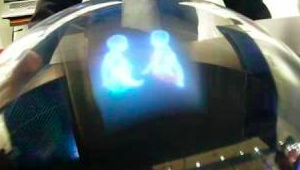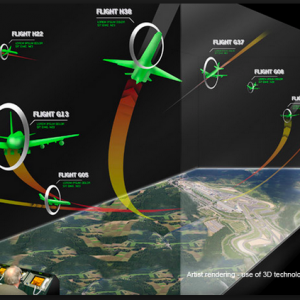aNewDomain — Spartacus never looked so vivid. Grey’s Anatomy never looked so … gross. This startling new 3D display tech will make even Buzz Aldrin’s storied spacewalk seem fresh again.
 Analysts say 3D volumetric displays will someday revolutionize not just the experience of 3D imagery, but also image applications in such fields as electronic surveilance, defense, education, meteorology, medicine and entertainment. One leading 3D display company to watch in this regard is up and comer 3DIcon.
Analysts say 3D volumetric displays will someday revolutionize not just the experience of 3D imagery, but also image applications in such fields as electronic surveilance, defense, education, meteorology, medicine and entertainment. One leading 3D display company to watch in this regard is up and comer 3DIcon.
3DIcon’s volumetric display-based Cspace, in development now, is a solid state system that renders and projects super high-res 3D images of up to 800 million volumetrix pixels (voxels), execs say. Key to this innovation is a promising new kind of laser glass and edgy TI Digital Light Processing (DLP) tech.
A sidenote: Solid state DLP tech, of course, follows Moore’s Law, so systems predictably will get faster every 18 months or so, and smaller and less inexpensive, too. 3DIcon’s Cspace system is only projecting monochrome 2-centimeter square images now. But full color 3D images that are 360-degree viewable on the inside and the outside are a lot closer to reality than you think. So I took a closer look.
How It Works
At the center of the Cspace system is that volumetric display. Volumetric displays work by projecting points of light into a three dimensional display area. The 3DIcon Cspace system is exciting because it utilizes a laser glass designed for high power- and ultra-short laser pulse applications. That should make it more cost-effective than competitive offerings, observers say.
The system creates the light using two lasers — 850 nm and the other at 1532 nm — at a nano-material packed substrate. The tiny nanomaterials inside vibrate when the lasers hit them, making them look and act much like your typical light-emitting phosphors. The visible light they emit is handled by two TI DLPs, which in turn lay sequential slices of a 2D image across a matrix of tiny mirrors. A true, 360-degree viewable image results.
 A volumetric display isn’t the only way to render 3D images, but analysts we interviewed say it has emerged as among the most promising from a cost and quality standpoint.
A volumetric display isn’t the only way to render 3D images, but analysts we interviewed say it has emerged as among the most promising from a cost and quality standpoint.
The Outlook for 3D Volumetric Displays
Where will such 3D volumetric displays as 3DIcon’s turn up first?
Like any cutting edge graphic display tech before it, you’ll see volumetric displays first in military, entertainment, medicine and any vertical market that currently relies on high-res 2D images.

At a recent Defense, Security and Sensing (DSS) meeting in Baltimore, 3DIcon called to mind the creation and delivery of holographic messages not unlike those that Princess Leia beamed to R2D2 in the first “Star Wars” film (1977).
Another sci-fi image 3DIcon calls to mind is that of Robert Downey Jr. as Tony Stark in “The Avengers,” in a scene where he deftly manipulates 3D images of his combat suit with just a wave of his hand.

For some more background on volumetric display tech, check out this backgrounder.
For aNewDomain, I’m Jim Kelly.













